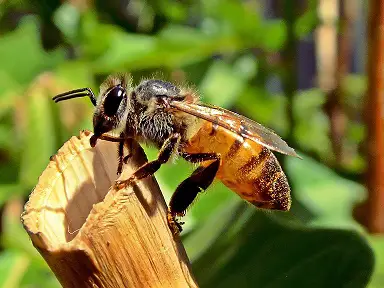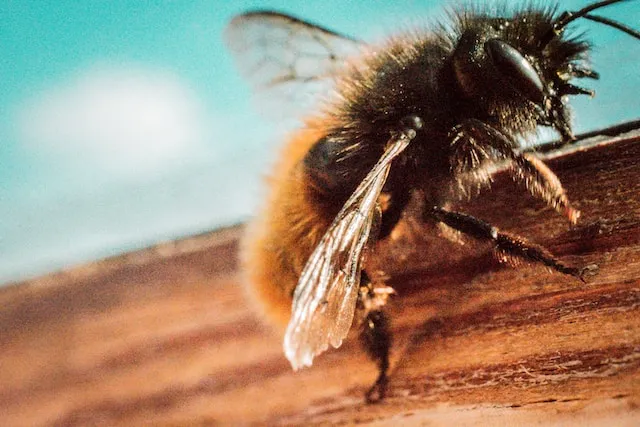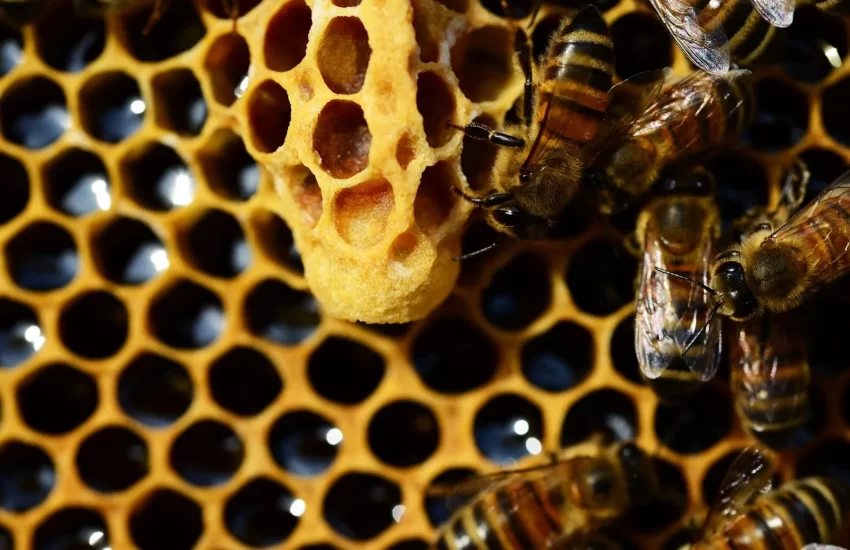Do Male Bees Die After Mating? Honey Bee Mating Behavior
Male bees, also referred to as drones, develop from unfertilized eggs. Their life cycle lasts for 24 days; from egg to adult. Unlike the worker bees, they do not possess a stinger, although they are bigger. Their eyes are two times larger than those of worker bees and help them as they follow the queen up in the air to mate.
There are only 200-300 drones in a bee nest out of a colony size of 50,000. Strong colonies contain a more significant number of drones compared to weak colonies. Their eyes make it easy to spot them in the hive when inspecting your colony.
Drone’s Position in the Territory
Their primary purpose in a colony is to mate with a viable queen to safeguard future honey bee generations. They don’t assist in protecting the hive from predators nor in honey production or feeding the brood. Surprisingly, they even depend on the worker bees to provide food.
However, their role cannot be underestimated in maintaining a healthy colony.
Similar Articles you may like to read –
What Happens When a Queen Bee Dies?
How long do queen bees live?
How quickly do bees multiply? Reproduction of Honey Bees
Are queen bees born or made?
How Many Times Does A Queen Bee Get Mated?
As they seek to mate with queens outside the territory, they help in genetic diversity, which is essential in species survival and when the colonies face severe threats of diseases and mites. In dearth and food shortage, the colony cannibalize and consumes them as food.
In spring and summer, they frequently leave the hive to seek Drone Congregation Areas (DCAs), anticipating to be included in the mating flight. These trips mostly happen on warm sunny afternoons.
In a bee colony, there is only one queen. The queen mates only once in a lifetime, which means most male bees die without getting a chance to play their role. However, the workers always keep them around in the hive just in case a new queen is required. A colony raises a queen when the former one dies, goes missing, or when the bee family wants to swarm.
Drones start leaving the hive for mating flights six days after emerging from the pupa.
Do Male Bees Die After Mating?
Yes, if a drone manages to mate with a queen, that is his end.
While mating, the male honey bee inserts his endophallus (sexual organs) into the queen. After successful copulation, he tries to fly away, but his sexual organs are torn apart and remain inside the queen. These parts stay on the queen’s body so that she can store the sperms in her body. The drone dies minutes or hours later.
Honey Bee Mating Behavior
Drones Meeting Points
Mating of honey bee queens and drones takes place away from the nest. This minimizes the chances of a queen and male bees from the same family to mate. Drones Assemble Areas (DCA’s) are particular sites where drones wait for the appearance of receptive queens. The areas have a diameter of between 30 and 200m and are usually 10-40 meters from the ground, generally above an open field away from hills, trees, or a forest canopy.
These areas are situated high in the air and often rebuilt in the same place every year. There can be up to 11000 drones from many different colonies. The boundaries of the meeting point are clear-cut, and the drones usually disregard queens flying a couple of meters away.
Drones can assemble from as many as 200 colonies in a congregation area. This comprehensive mixing of drones ensures a virgin queen gets genetic diversity in her territory.
The Mating Contest
The viable queen also leaves the hive and takes off on a “mating flight” journey to find potential drones in their assembly area. Before this trip, she takes other short flights to strengthen her wings.
When a queen arrives in the meeting area, and the drones locate her, it is usually a race of the fittest to mate with the virgin queen. Since the drones are more than the queens by far, only 10-20 of them manage to mate with her.
During her flight, she mates with an average of 12 drones. She can undertake numerous nuptial flights to get enough sperms from the drones. Every time she mates with a single drone, she gets numerous sperms into her oviducts which are then transported to spermatheca(sperm storage sacs). Once the sperm sac is full, it lasts her a whole egg-laying period. A queen can live upto 5 years but the average lifespan is 2-3 years. Three days after her “nuptial flights,” the queen starts to lay eggs.
The Mating Process
The Drone’s sexual organ is fabricated in a way that helps it to disperse to diffuse a large quantity of semen into the queen with great speed and force. During copulation, the internally held endophallus is turned inside out and inserted into the queen.
The mating process only lasts for less than 5 seconds. The ejaculation is forceful so that it ends up ripping apart the male organs. A human ear can sometimes hear it as a popping sound. The organ left in the queen’s body is known as a mating mark and does not hinder the mating of the next drones.
Post-Mating Fate of Male Bees
Contrary to popular belief, male bees do not necessarily die immediately after mating. Instead, their fate depends on various factors, including environmental conditions and the reproductive success of the queen. While some drones may perish shortly after mating due to exhaustion or predation, others may return to the colony to await another opportunity to mate. However, as the mating season progresses, colonies typically begin to expel surplus drones to conserve resources for the winter months.
Implications for Bee Colony Dynamics
Understanding the mating behavior of honey bees and the fate of male bees after mating has significant implications for bee colony dynamics and survival. By contributing to genetic diversity through mating, drones play a vital role in ensuring the resilience of honey bee populations. Additionally, the expulsion of surplus drones helps maintain the optimal balance of resources within the colony, enhancing its overall health and productivity.
What Happens to Drones That Don’t Mate with the Queen?
As mentioned earlier, only a tiny percentage of the male bees succeed in mating with the queen. Some drones may be successful in tracing back their original hives. Others drift to other colonies, while others may get lost to predation. Drifting to other territories may spread parasites and diseases among honey bee colonies. Amazingly, drones can fly back to any hive without confrontation by the guard bees.
The Fate of Drones in Winter
Drones depend on the worker bees to supply pollen, honey, gland secretions. There must be abundant and continuous pollen flow into the nest to keep them healthy.
Towards winter in late autumn, drones are evicted from the colony. Their services are unessential in this inactive season. The colony’s goal is to save as many food reserves as possible. So the busybodies cannot be accommodated.
The workers start by starving them to be weak; ultimately, they lead them to the entrance and throw them out, where they die of starvation and cold. A colony then starts to raise drones in spring. Their optimal population coincides with the swarming season in the late spring and early summer.
However, colonies with a high population and abundant honey reserves or without a queen may allow the drones to stay through the winter season.
LifeSpan of Male Bees
Drones live for barely a few weeks, but some can live up to 90 days. The drones that mate with the queen bee have shorter lives; hence, a drawback has advantages.
FAQs
How many drones mate with the queen?
Out of the vast numbers of drones from different colonies, only an average of 12 males manage to mate with a queen.
Do drones mate with a queen from the same territory?
The chances of a drone to mate with the queen from the same nest is very minimal. Drones from many colonies await receptive queens in drone assembly areas where the stiff contest occurs.
Why do drones die after mating?
The drones can’t survive after mating. Together with the linked parts, their reproductive organs are ripped apart during copulation.
More articles you may like to read –
Are bees active at night?
What Happens When a Queen Bee Dies?
Types of Honey Bees, Honey Bee Stocks
How far do honey bees travel from the hive?
Interesting Facts About Honey Bees
How do drones die?
Drones usually die in awful ways. Some die after mating with the queen, while others die of predation. Those that manage to see the end of autumn are starved and evicted from the hive by the worker bees.
How long do bees mate?
A queen and a drone take less than 5 seconds to mate.
Are virgin queens smaller in size?
Yes, virgin queens are smaller than mated ones since they are not fully developed. It takes six days for them to mature after hatching.
Can a Queen fly?
Yes, a queen can fly. She flies on her nuptial flights and when a colony is swarming or absconding a nest.



